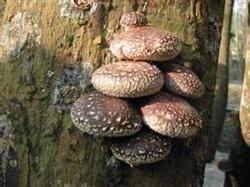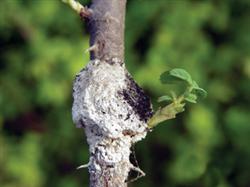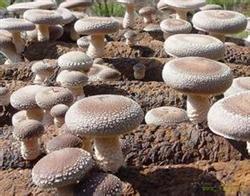Off-season cultivation techniques of Lentinus edodes

1. The cultivation site should be far away from the livestock and poultry barn, pollution-free, ventilated and cool, and close to the water source. The mushroom shed is cultivated in the open field or semi-underground. two。 The cultivation season is generally arranged in early December and in January. The mushrooms were produced from June to August of the following year. 3. Culture material formula ① sawdust 78%, wheat bran 20%, gypsum 2%, potassium dihydrogen phosphate 0.3%. ② cottonseed hull 44%, sawdust 40%, wheat bran 12%, corn flour 3%, gypsum powder 1%. Cottonseed hulls or bran are fresh and mildew-free. Expose to the sun for 3-5 days before use. The ratio of material to water is 1: 1.2 and the pH value is 6: 6.5. After mixing, the material is packed and bagged for 2 hours to sterilize. 4. 15 cm × 45 cm × 0.04 cm low-pressure polyethylene plastic bags are selected for the production of bacteria cylinders, each containing about 0.75 kg of dry material, and the bag should be completed within 4 hours. The temperature of atmospheric pressure sterilization stove should reach 100 ℃ within 4 hours and be maintained for 8 hours and 12 hours. Cool to 25 ℃ after sterilization, drill holes and inoculate according to the requirements of aseptic operation, and use about 10% of seeds. After inoculation, the cultivation bag was moved into the culture room, incubated in the dark for 24 ℃, the air humidity was 60% and 70%, and the bacteria were ventilated and ventilated. After 40-50 days, the hyphae could grow all over the bag, showing bulge and local color change. 5. Take off the bag and the mycelium in the upper shed for 20-30 days, remove the bag, and carefully place the tube on the mushroom rack with an interval of 5 cm. In order to prevent the bacteria tube from being dehydrated, sprinkle water to the ground to moisturize. If the temperature in the shed exceeds 25 ℃, the vents can be opened for a short time to cool down. When the short villous mycelium on the surface of the tube grows to 2 mm, increase the number of times of cooling and humidity to promote the formation of bacterial membrane. During the period of bacterial film formation and color conversion, the temperature in the shed was 19: 22 ℃, and with proper increase of light, the bacterial film could turn to reddish brown in about 7-10 days. 6. Management of mushroom budding period after changing color, the temperature difference between day and night should be increased to stimulate the formation of mushroom buds. Increase ventilation at night to cool down, increase temperature during the day, keep the relative humidity in the shed 80%-85%, and spray water appropriately when the temperature is too low. The air hole is opened 2 or 3 times a day to promote the formation of mushroom buds. When the mushroom buds are the size of broad beans, water is sprayed once in the morning, in the middle and in the evening, to the degree of moisture on the ground and mushroom buds. During the mushroom emergence period, the temperature was kept at 18-25 ℃, and the light was appropriately increased during the day to deepen the color of the fruiting body of Lentinus edodes and develop normally. 7. When the edge of the mushroom cover is rolled like a gong, it should be harvested in time, big and small, so as not to damage the small mushroom buds. After harvesting, the first tide mushroom can open the ventilation hole, ventilate for 4-5 hours, lower the temperature in the greenhouse, and then build the greenhouse to raise bacteria, and enlarge the temperature difference between day and night to stimulate the formation of the second batch of mushroom bacteria.
- Prev

Prevention and rejuvenation of rose aging
Symptoms: mainly harm flowers, leaves and twigs. At the beginning, water-stained spots appeared on the petals or the tips and edges of the petals turned brown, rapidly expanded, wilted and rotted, and finally the whole flower turned brown and withered. Grey green mould can be seen under wet conditions, namely conidia and conidia of pathogenic bacteria. Symptoms of the disease:
- Next

Control of Diseases and insect pests in the cultivation of Lentinus edodes
There are many kinds of miscellaneous bacteria parasitic on mushroom wood, such as Trichoderma, Schizophyllum, birch, fan and so on. In terms of pests, slugs, snails, horse land, etc., harmful to fresh mushrooms, longicorn beetles, bark beetles and termites harmful to mushroom trees. Should carry out the policy of "prevention first, comprehensive prevention and cure" on prevention and cure, add.
Related
- Fuxing push coffee new agricultural production and marketing class: lack of small-scale processing plants
- Jujube rice field leisure farm deep ploughing Yilan for five years to create a space for organic food and play
- Nongyu Farm-A trial of organic papaya for brave women with advanced technology
- Four points for attention in the prevention and control of diseases and insect pests of edible fungi
- How to add nutrient solution to Edible Fungi
- Is there any good way to control edible fungus mites?
- Open Inoculation Technology of Edible Fungi
- Is there any clever way to use fertilizer for edible fungus in winter?
- What agents are used to kill the pathogens of edible fungi in the mushroom shed?
- Rapid drying of Edible Fungi

